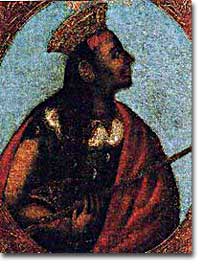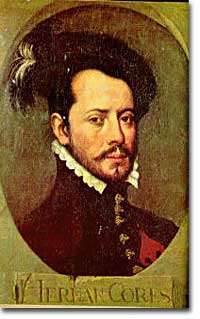11e. Clash of Cultures: Two Worlds Collide
Montezuma was the unluckiest of kings. History elected him to oversee the ruin of the last great Central American empire. Other Aztec rulers had encountered setbacks in their conquests. For Montezuma it was different. He confronted an alien empire from across the sea. In its leader, the Spaniard Hernan Cortez, he faced an opponent as astute and skillful as himself. In the end, Cortez proved the more determined of the two.
In the wake of Columbus' historic voyage in 1492, expeditions, especially from Imperial Spain, swarmed into Aztec territory. They came in search of gold and souls — gold to enrich the coffers of the Spanish king (and their own), and heathen souls to rescue for Christianity. Within a generation, America's ancient civilizations were crushed. Both the Aztec and Inca Empires collapsed after campaigns lasting just a couple of years. How did they fall so fast? Historians suggest many causes.
Cannons vs. Clubs
The Spanish army was the most ruthless fighting force on earth. It had not suffered a single defeat for 150 years. The Spaniards possessed cannon and arquebus (primitive muskets) which terrified the American tribes. Horses, which the Aztecs had never encountered, gave the Spaniards greater mobility. Above all there was the Spanish sword. It could kill with a single lightning thrust. Against all this, the Aztec's primary weapons were wooden clubs studded with obsidian glass.
Wars were religious rituals to the Aztecs. A prime objective was the capture of prisoners for sacrifice. During the siege of Tenochtitlan, conquistadors watched from a distance. They were horrified as Aztecs dragged captives up the steps of the Great Temple and ripped out their hearts. The Spanish viewed the Aztecs as savages.
Aztec warriors had several opportunities to kill Cortez. Each time they tried to capture him alive — and each time he escaped. Spaniards killed Aztec leaders whenever they could. Prominent in their brightly feathered costumes, they often led the warrior ranks. With their deaths, ordinary soldiers became demoralized and fled.

Atahuallpa was the last Inca king. He was captured by Francisco Pizarro, who received tons of gold and silver for Atahuallpa's safe release. After converting to Christianity in order to prevent being burned alive, Atahuallpa was strangled to death and then burned by Pizarro's men.
Dissention and Disease
The Aztec Empire was a loose confederation of allies and subject states. Many deeply resented Aztec rule, their dreaded tax collectors, and the massive tributes they paid. In the Spanish, they saw their saviors. Cortez exploited this unrest with great skill. In his final assault on Tenochtitlan, his band of 900 Spanish soldiers was joined by perhaps 150,000 natives.
The Europeans brought with them diseases such as measles and smallpox against which the American tribes had no natural immunity. They spread like wildfire, killing rulers of both the Aztecs and Incas, along with millions of other people.
Finally, the personalities of Montezuma and Hernan Cortez must be considered. Both were gifted generals and wily politicians. But while Cortez was a hardheaded realist, Montezuma was mired in magic and superstition.
Self-Fulfilling Prophecy
Long before Cortez landed at Vera Cruz on Good Friday, 1519, portents of doom appeared. A comet "bright as to turn night into day" lit the sky. Dismayed soothsayers and astrologers maintained they did not see it. For this unhelpful approach, Montezuma cast them into cages where they starved to death. Then, an important temple burned. Lastly, hunters brought Montezuma a bird with a mirror strapped to its head. In it he saw large numbers of people "advance as for war; they appeared to be half men half deer."
How much of this is fact? How much is myth? By the time spies brought tales of mountains floating upon the sea (Spanish galleons), and men with "flesh very white...a long beard and hair to their ears," Montezuma's nerves were shattered. Was this the legendary feathered serpent god, Quetzalcotl, who having vanished into the eastern ocean, now returned?
Montezuma half-convinced himself Cortez was a god.

Hernando Cortés and conquistadors like him looted the land of the Aztecs. Cortés brought home gold, silver, and jewels from the New World which inspired settlement in the Americas.
He sent Cortez the feathery costume of Quetzalcotl with other gifts, including "twenty ducks made of gold, very natural looking." Cortez took the bold move of marching on Tenochtitlan. With a force of 500 Spanish soldiers and whatever warriors he recruited along the way, he faced Montezuma on the city's southern causeway on November 8, 1519. Montezuma invited him in.
The Ancient Civilizations Crumble
Was this a political blunder or a shrewd tactical move? Once inside the city, Cortez found himself isolated, at the mercy of the Aztec Empire. He quickly rectified matters. In another bold stroke, he kidnapped Montezuma. With 30 seasoned soldiers, he entered the royal palace and gave the Emperor a stark choice — come with us, or die. Montezuma, fearful, puzzled, dejected, disorientated by these men-gods, submitted.
Months later, while trying to calm a rebellion against the interlopers, Montezuma was killed in a firestorm of rocks and javelins. Cortez and his crew barely escaped with their lives.
Nine months later he returned with a huge army of Spaniards and native recruits. First they set siege to Tenochtitlan, denying it food and fresh water. On August 13, 1521, Tenochtitlan fell. A decade later, the Incas, plagued by civil war and decimated by smallpox, faced Francisco Pizarro. They suffered a similar fate.
These great civilizations live on — in their legends, their art and architecture, lovingly reclaimed by archaeologists and historians. Their foods transformed Europe — tomatoes, corn, and potatoes became staple foods of much of the Old World's growing population. A new Atlantic World that incorporated elements of European, African, and American cultures was taking shape.







